New Self-Organizing Optical Materials and Induced Polymorphic Phases of Their Mixtures Targeted for Energy Investigations
Abstract
:1. Introduction
2. Experimental
2.1. Synthesis
2.1.1. Synthesis of 4-(((4-Fluorophenyl)imino)methyl)-2-methoxyphenol
2.1.2. Synthesis 4-(((4-Fluorophenyl)imino)methyl)-2-methoxyphenyl 4-alkoxybenzoate, In
- 4-(((4-Fluorophenyl)imino)methyl)-2-methoxyphenyl 4-(hexyloxy)benzoate I6
- 4-(((4-Fluorophenyl)imino)methyl)-2-methoxyphenyl 4-(octyloxy)benzoate I8
- 4-(((4-Fluorophenyl)imino)methyl)-2-methoxyphenyl 4-(decyloxy)benzoate I10
- 4-(((4-Fluorophenyl)imino)methyl)-2-methoxyphenyl 4-(dodecyloxy)benzoate I12
2.2. Characterization
2.3. Computational Method
3. Results and Discussion
3.1. Liquid Crystalline Properties
3.2. Geometrical Structures
3.2.1. Frontier Molecular Orbitals (FMOs)
3.2.2. Molecular Electrostatic Potential (MEP)
3.3. Binary Phase Diagram
3.4. UV-Vis Absorption Spectra
3.5. Fluorescence Spectra
4. Conclusions
Supplementary Materials
Author Contributions
Funding
Institutional Review Board Statement
Informed Consent Statement
Data Availability Statement
Acknowledgments
Conflicts of Interest
References
- Saccone, M.; Kuntze, K.; Ahmed, Z.; Siiskonen, A.; Giese, M.; Priimagi, A. Ortho-Fluorination of azophenols increases the mesophase stability of photoresponsive hydrogen-bonded liquid crystals. J. Mater. Chem. C 2018, 6, 9958–9963. [Google Scholar] [CrossRef]
- Jessy, P.; Radha, S.; Patel, N. Morphological, optical and dielectric behavior of chiral nematic liquid crystal mixture: Study on effect of different amount of chirality. J. Mol. Liq. 2018, 255, 215–223. [Google Scholar] [CrossRef]
- Mishra, R.; Hazarika, J.; Hazarika, A.; Gogoi, B.; Dubey, R.; Bhattacharjee, D.; Singh, K.N.; Alapati, P.R. Dielectric properties of a strongly polar nematic liquid crystal compound doped with gold nanoparticles. Liq. Cryst. 2018, 45, 1661–1671. [Google Scholar] [CrossRef]
- Alamro, F.S.; Ahmed, H.A.; El-Atawy, M.A.; Al-Zahrani, S.A.; Omar, A.Z. Induced Nematic Phase of New Synthesized Laterally Fluorinated Azo/Ester Derivatives. Molecules 2021, 26, 4546. [Google Scholar] [CrossRef] [PubMed]
- Nessim, R.I.; Naoum, M.M.; Mohamed, S.Z.; Nessim, M.I. Effect of molecular structure on the phase behaviour of some liquid crystalline compounds and their mixtures XIII. 4-(4-Substituted phenylazo) phenyl 4-alkoxybenzoates. Liq. Cryst. 2004, 31, 649–654. [Google Scholar] [CrossRef]
- Jin, C.; Shi, X.; Zeng, H.; Han, S.; Chen, Z.; Yang, Z.; Mutailipu, M.; Pan, S. Hydroxyfluorooxoborate Na [B3O3F2 (OH)2]⋅[B (OH)3]: Optimizing the Optical Anisotropy with Heteroanionic Units for Deep Ultraviolet Birefringent Crystals. Angew. Chem. 2021, 133, 20632–20638. [Google Scholar] [CrossRef]
- Jin, C.; Zeng, H.; Zhang, F.; Qiu, H.; Yang, Z.; Mutailipu, M.; Pan, S. Guanidinium Fluorooxoborates as Efficient Metal-free Short-Wavelength Nonlinear Optical Crystals. Chem. Mater. 2021, 34, 440–450. [Google Scholar] [CrossRef]
- Żurowska, M.; Dziaduszek, J.; Szala, M.; Morawiak, P.; Bubnov, A. Effect of lateral fluorine substitution far from the chiral center on mesomorphic behaviour of highly titled antiferroelectric (S) and (R) enantiomers. J. Mol. Liq. 2018, 267, 504–510. [Google Scholar] [CrossRef]
- Kašpar, M.; Bubnov, A.; Hamplová, V.; Málková, Z.; Pirkl, S.; Glogarová, M. Effect of lateral substitution by fluorine and bromine atoms in ferroelectric liquid crystalline materials containing a 2-alkoxypropanoate unit. Liq. Cryst. 2007, 34, 1185–1192. [Google Scholar] [CrossRef]
- Cigl, M.; Bubnov, A.; Kašpar, M.; Hampl, F.; Hamplová, V.; Pacherová, O.; Svoboda, J. Photosensitive chiral self-assembling materials: Significant effects of small lateral substituents. J. Mater. Chem. C 2016, 4, 5326–5333. [Google Scholar] [CrossRef]
- Boychuk, A.; Shibaev, V.; Cigl, M.; Pomeisl, K.; Hamplová, V.; Pociecha, D.; Bubnov, A.; Bobrovsky, A. Photo-orientation Processes in Liquid Crystalline Polymethacrylates with Side Azobenzene Groups Having Lateral Methyl Substituents. Macromolecules 2021, 54, 10499–10509. [Google Scholar] [CrossRef]
- Stamatoiu, O.; Bubnov, A.; Ţârcomnicu, I.; Iovu, M. Synthesis and spectral characterisation of new amido-ether Schiff bases. J. Mol. Struct. 2008, 886, 187–196. [Google Scholar] [CrossRef]
- Alamro, F.S.; Gomha, S.M.; Shaban, M.; Altowyan, A.S.; Abolibda, T.Z.; Ahmed, H.A. Optical investigations and photoactive solar energy applications of new synthesized Schiff base liquid crystal derivatives. Sci. Rep. 2021, 11, 15046. [Google Scholar]
- Gray, G.W.; Luckhurst, G. The Molecular Physics of Liquid Crystals; Academic Press: Cambridge, MA, USA, 1979. [Google Scholar]
- Dave, J.S.; Menon, M. Azomesogens with a heterocyclic moiety. Bull. Mater. Sci. 2000, 23, 237–238. [Google Scholar] [CrossRef]
- Abberley, J.P.; Killah, R.; Walker, R.; Storey, J.M.; Imrie, C.T.; Salamończyk, M.; Zhu, C.; Gorecka, E.; Pociecha, D. Heliconical smectic phases formed by achiral molecules. Nat. Commun. 2018, 9, 228. [Google Scholar] [CrossRef] [PubMed] [Green Version]
- Paterson, D.A.; Crawford, C.A.; Pociecha, D.; Walker, R.; Storey, J.M.; Gorecka, E.; Imrie, C.T. The role of a terminal chain in promoting the twist-bend nematic phase: The synthesis and characterisation of the 1-(4-cyanobiphenyl-4′-yl)-6-(4-alkyloxyanilinebenzylidene-4′-oxy) hexanes. Liq. Cryst. 2018, 45, 2341–2351. [Google Scholar] [CrossRef]
- Durgapal, S.D.; Soni, R.; Soman, S.S.; Prajapati, A. Synthesis and mesomorphic properties of coumarin derivatives with chalcone and imine linkages. J. Mol. Liq. 2020, 297, 111920–111931. [Google Scholar] [CrossRef]
- Chen, R.; An, Z.; Wang, W.; Chen, X.; Chen, P. Lateral substituent effects on UV stability of high-birefringence liquid crystals with the diaryl-diacetylene core: DFT/TD-DFT study. Liq. Cryst. 2017, 44, 1515–1524. [Google Scholar] [CrossRef]
- Ahmed, H.A.; Aboelnaga, A. Synthesis and mesomorphic study of new phenylthiophene liquid crystals. Liq. Cryst. 2021, 1–8. [Google Scholar] [CrossRef]
- Han, S.-Q.; Chen, Y.-Y.; Xu, B.; Wei, J.; Yu, Y.-L. An azoester-containing photoresponsive linear liquid crystal polymer with good mesophase stability. Chin. J. Polym. Sci 2020, 38, 806–813. [Google Scholar] [CrossRef]
- Gray, G.W. Molecular Structure and the Properties of Liquid Crystals; Academic Press: Cambridge, MA, USA, 1962. [Google Scholar]
- Paterson, D.A.; Gao, M.; Kim, Y.-K.; Jamali, A.; Finley, K.L.; Robles-Hernández, B.; Diez-Berart, S.; Salud, J.; de la Fuente, M.R.; Timimi, B.A. Understanding the twist-bend nematic phase: The characterisation of 1-(4-cyanobiphenyl-4′-yloxy)-6-(4-cyanobiphenyl-4′-yl) hexane (CB6OCB) and comparison with CB7CB. Soft Matter 2016, 12, 6827–6840. [Google Scholar] [CrossRef] [PubMed] [Green Version]
- Sarkar, D.D.; Deb, R.; Chakraborty, N.; Mohiuddin, G.; Nath, R.K.; Nandiraju, V.R. Cholesterol-based dimeric liquid crystals: Synthesis, mesomorphic behaviour of frustrated phases and DFT study. Liq. Cryst. 2013, 40, 468–481. [Google Scholar] [CrossRef]
- Majumdar, K.; Mondal, S.; Sinha, R.K. Synthesis and characterization of novel cholesterol based mesogenic compounds using ‘click’chemistry. New J. Chem. 2010, 34, 1255–1260. [Google Scholar] [CrossRef]
- Kaur, G.; Singh, S.; Sreekumar, A.; Choudhury, A.R. The evaluation of the role of C–H⋯F hydrogen bonds in crystal altering the packing modes in the presence of strong hydrogen bond. J. Mol. Struct. 2016, 1106, 154–169. [Google Scholar] [CrossRef]
- Al-Mutabagani, L.A.; Alshabanah, L.A.; Ahmed, H.A.; El-Atawy, M.A. Synthesis, optical and DFT characterizations of laterally fluorinated phenyl cinnamate liquid crystal non-symmetric system. Symmetry 2021, 13, 1145. [Google Scholar] [CrossRef]
- El-Atawy, M.A.; Naoum, M.M.; Al-Zahrani, S.A.; Ahmed, H.A. New nitro-laterally substituted azomethine derivatives; Synthesis, mesomorphic and computational characterizations. Molecules 2021, 26, 1927. [Google Scholar] [CrossRef]
- Ahmed, H.A.; El-Atawy, M.A. Synthesis, Mesomorphic and Geometrical approaches of New non-symmetrical System based on central Naphthalene moiety. Liq. Cryst. 2021, 48, 1940–1952. [Google Scholar] [CrossRef]
- El-Atawy, M.A.; Alhaddad, O.A.; Ahmed, H.A. Experimental and geometrical structure characterizations of new synthesized laterally fluorinated nematogenic system. Liq. Cryst. 2021, 48, 2106–2116. [Google Scholar] [CrossRef]
- Al-Zahrani, S.A.; Ahmed, H.A.; El-Atawy, M.A.; Abu Al-Ola, K.A.; Omar, A.Z. Synthetic, Mesomorphic, and DFT Investigations of New Nematogenic Polar Naphthyl Benzoate Ester Derivatives. Materials 2021, 14, 2587. [Google Scholar] [CrossRef]
- Khan, M.T.; Almohammedi, A. Effect of CdS nanocrystals on charge transport mechanism in poly (3-hexylthiophene). J. Appl. Phys. 2017, 122, 075502. [Google Scholar] [CrossRef]
- Babkair, S.S.; Azam, A.; Singh, K.; Dhawan, S.K.; Khan, M.T. Synthesis and optoelectrical properties of f-graphene/cadmium selenide hybrid system. J. Nanophotonics 2015, 9, 093048. [Google Scholar] [CrossRef] [Green Version]
- Alamro, F.S.; Ahmed, H.A.; Mostafa, A.M.; Naoum, M.M. Thermal and Mesomorphic Investigations of 1: 1 Supramolecular Assemblies of 4-[(4-(n-Alkoxy) phenylimino) methyl] benzoic Acids Having Symmetrical and Un-Symmetrical Terminal Chain Lengths. Symmetry 2021, 13, 1785. [Google Scholar] [CrossRef]
- Alamro, F.S.; Ahmed, H.A.; Popoola, S.A.; Aboelnaga, A. Synthesis, Phase Behavior and Computational Simulations of a Pyridyl-Based Liquid Crystal System. Molecules 2021, 26, 6416. [Google Scholar] [CrossRef] [PubMed]
- Imrie, C.; Taylor, L. The preparation and properties of low molar mass liquid crystals possessing lateral alkyl chains. Liq. Cryst. 1989, 6, 1–10. [Google Scholar] [CrossRef]
- Gomha, S.M.; Ahmed, H.A.; Shaban, M.; Abolibda, T.Z.; Alharbi, K.A.; Alalawy, H.H. New nematogenic conical-shaped supramolecular H-bonded complexes for solar energy investigations. Sci. Rep. 2021, 11, 17622. [Google Scholar] [CrossRef]
- Baluja, S.; Pandya, N.; Vekariya, N. A thermal study of some Schiff bases derivative of α-napthylamine. Russ. J. Phys. Chem. A Focus Chem. 2008, 82, 1601–1604. [Google Scholar] [CrossRef]
- Frisch, M.; Trucks, G.; Schlegel, H.B.; Scuseria, G.; Robb, M.; Cheeseman, J.; Scalmani, G.; Barone, V.; Mennucci, B.; Petersson, G. Gaussian 09, Revision a. 02; Gaussian Inc.: Wallingford, CT, USA, 2009; Volume 200. [Google Scholar]
- Dennington, R.; Keith, T.; Millam, J.; GaussView, V. Shawnee Mission KS, GaussView, Version; Semichem Inc.: Shawnee, KS, USA, 2009; Volume 5. [Google Scholar]
- Bobrovsky, A.; Shibaev, V.; Cigl, M.; Hamplová, V.; Dorovatovskii, P.; Ostrovskii, B.; Bubnov, A. The effect of spacer and alkyl tail lengths on the photoorientation processes in amorphousized films of azobenzene-containing liquid crystalline polymethacrylates. Liq. Cryst. 2020, 47, 377–383. [Google Scholar] [CrossRef]
- Poryvai, A.; Bubnov, A.; Pociecha, D.; Svoboda, J.; Kohout, M. The effect of the length of terminal n-alkyl carboxylate chain on self-assembling and photosensitive properties of chiral lactic acid derivatives. J. Mol. Liq. 2019, 275, 829–838. [Google Scholar] [CrossRef]
- Chemla, D.S. Nonlinear Optical Properties of Organic Molecules and Crystals V1; Elsevier: Amsterdam, The Netherlands, 2012; Volume 1. [Google Scholar]
- Khoo, I.-C.; Wu, S.-T. Optics and Nonlinear Optics of Liquid Crystals; World Scientific: Singapore, 1993; Volume 1. [Google Scholar]
- Date, R.; Imrie, C.; Luckhurst, G.; Seddon, J. Smectogenic dimeric liquid crystals. The preparation and properties of the α, ω-bis (4-n-alkylanilinebenzylidine-4′-oxy) alkanes. Liq. Cryst. 1992, 12, 203–238. [Google Scholar] [CrossRef]
- Elshakre, M.E.; Alalawy, H.H.; Awad, M.I.; El-Anadouli, B.E. On the role of the electronic states of corrosion inhibitors: Quantum chemical-electrochemical correlation study on urea derivatives. Corros. Sci. 2017, 124, 121–130. [Google Scholar] [CrossRef]
- Scrocco, E.; Tomasi, J. Electronic molecular structure, reactivity and intermolecular forces: An euristic interpretation by means of electrostatic molecular potentials. In Advances in Quantum Chemistry; Elsevier: Amsterdam, The Netherlands, 1978; Volume 11, pp. 115–193. [Google Scholar]
- Politzer, P.; Murray, J.S. Relationships between dissociation energies and electrostatic potentials of C–NO2 bonds: Applications to impact sensitivities. J. Mol. Struct. 1996, 376, 419–424. [Google Scholar] [CrossRef]
- Marks, T.J.; Ratner, M.A. Design, synthesis, and properties of molecule-based assemblies with large second-order optical nonlinearities. Angew. Chem. Int. Ed. Engl. 1995, 34, 155–173. [Google Scholar] [CrossRef]
- Tauc, J.; Grigorovici, R.; Vancu, A. Optical properties and electronic structure of amorphous germanium. Phys. Status Solidi B 1966, 15, 627–637. [Google Scholar] [CrossRef]

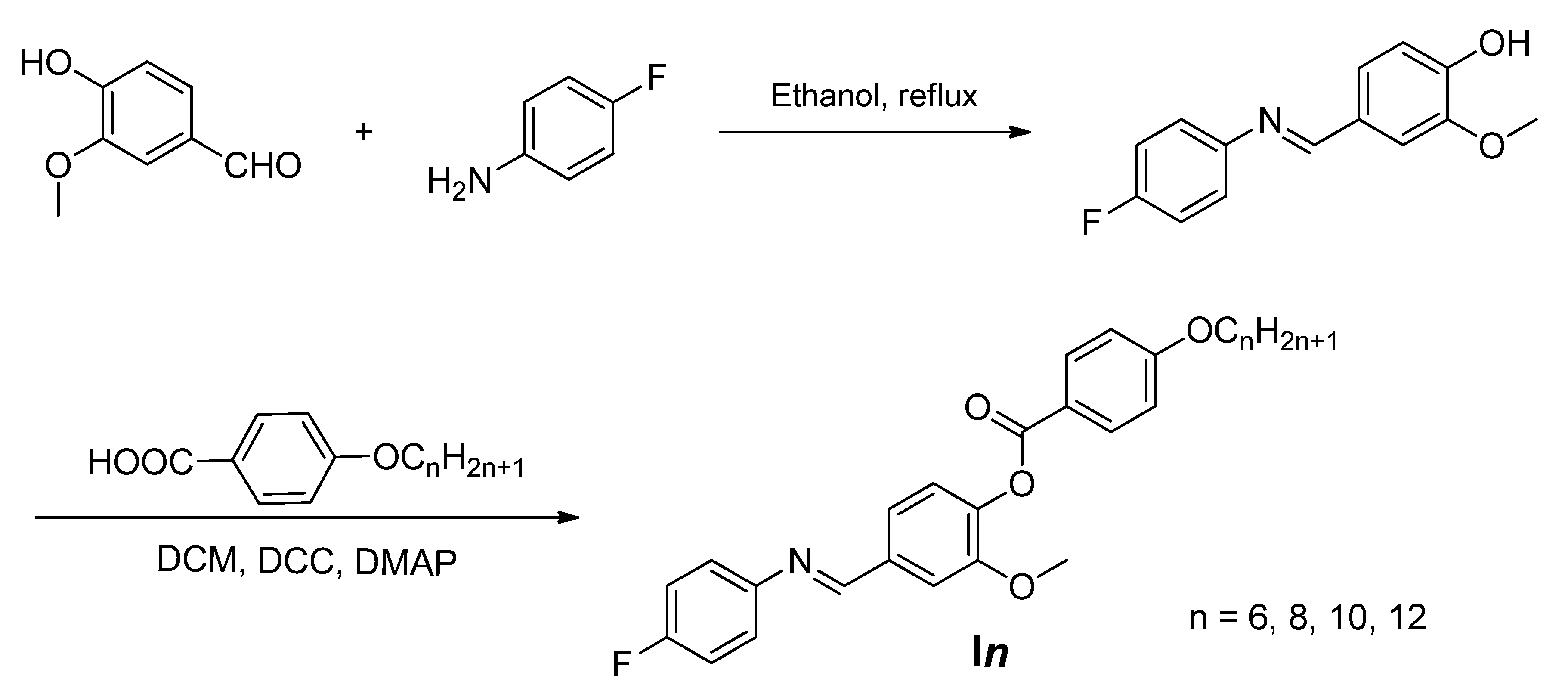

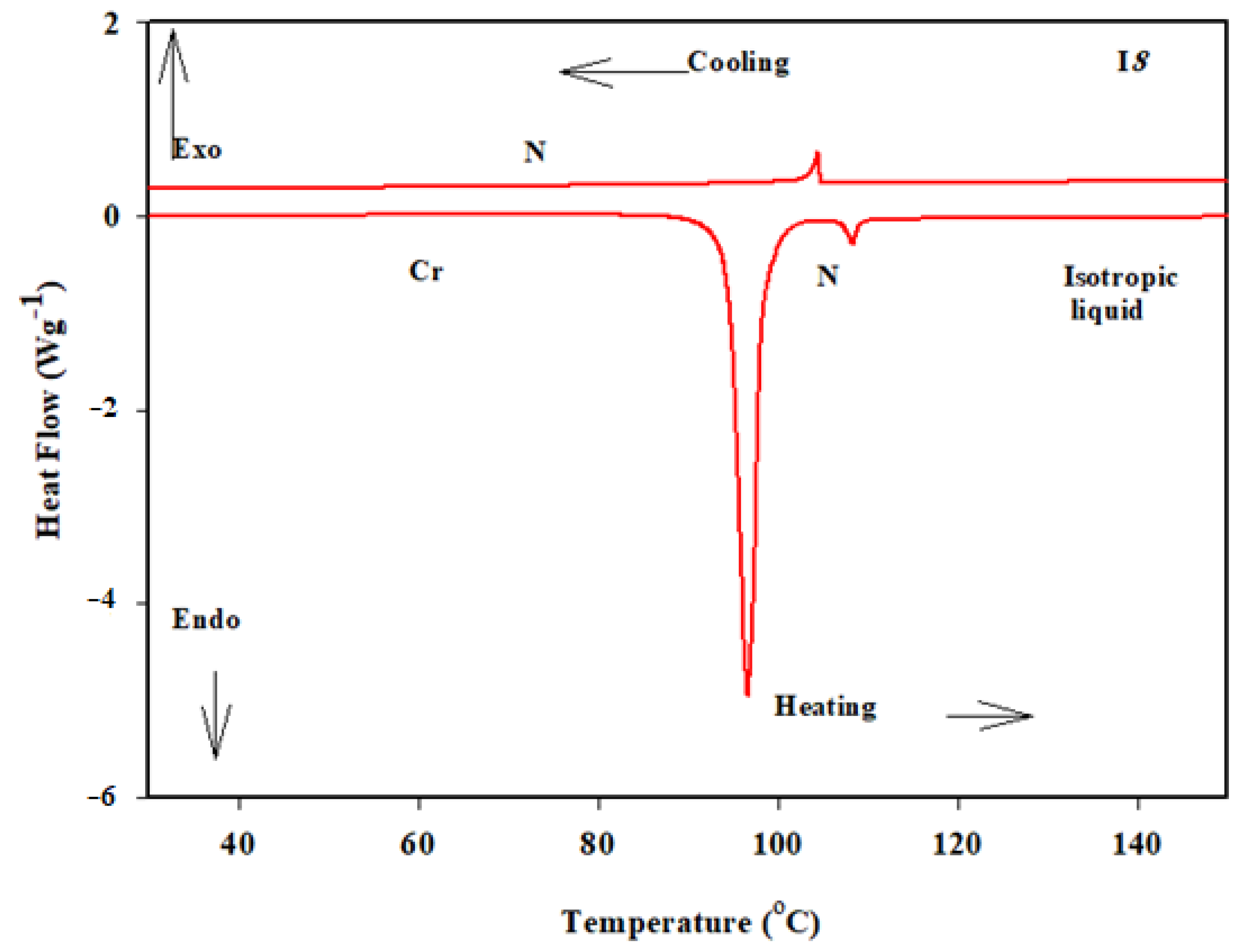

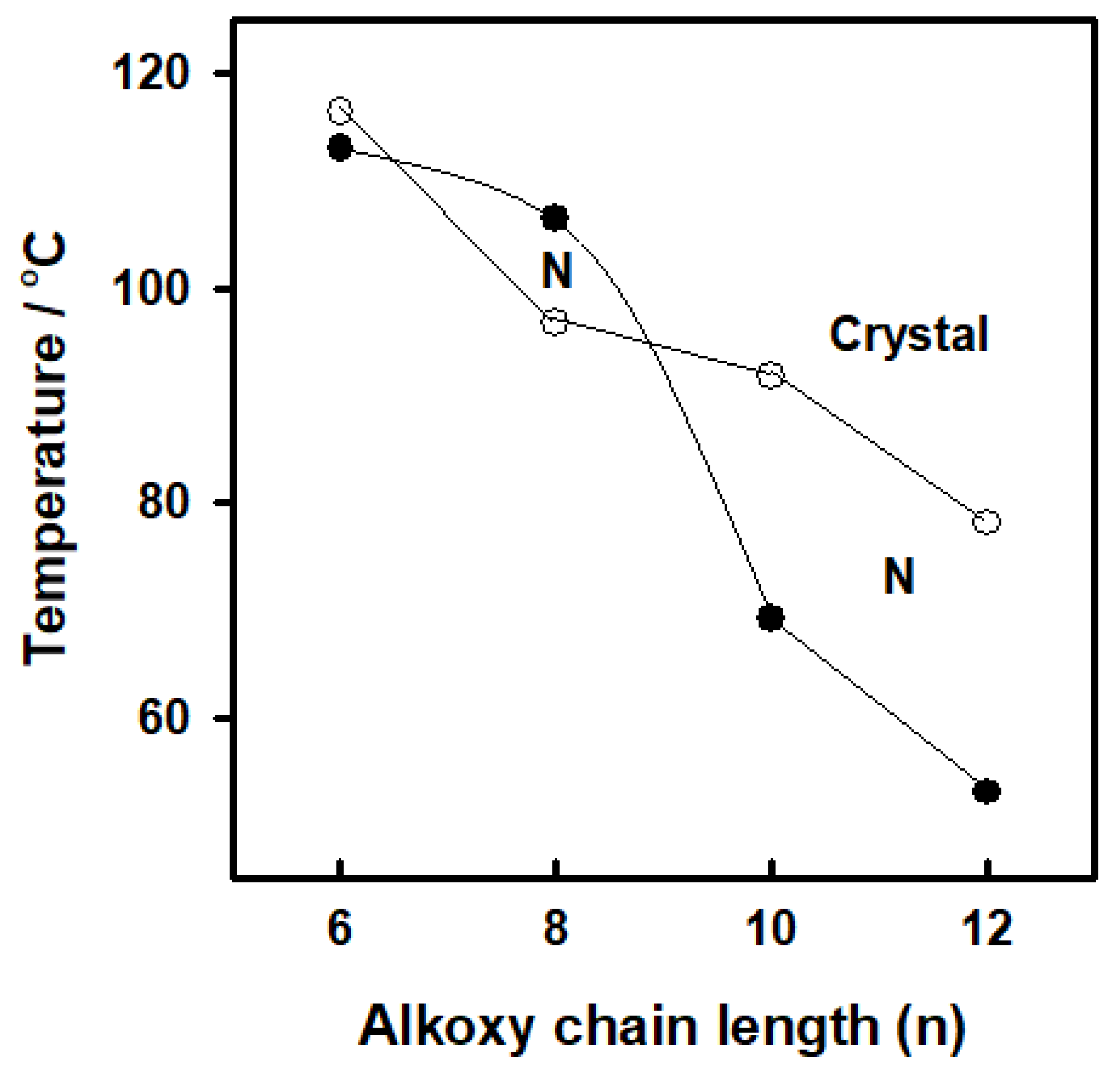
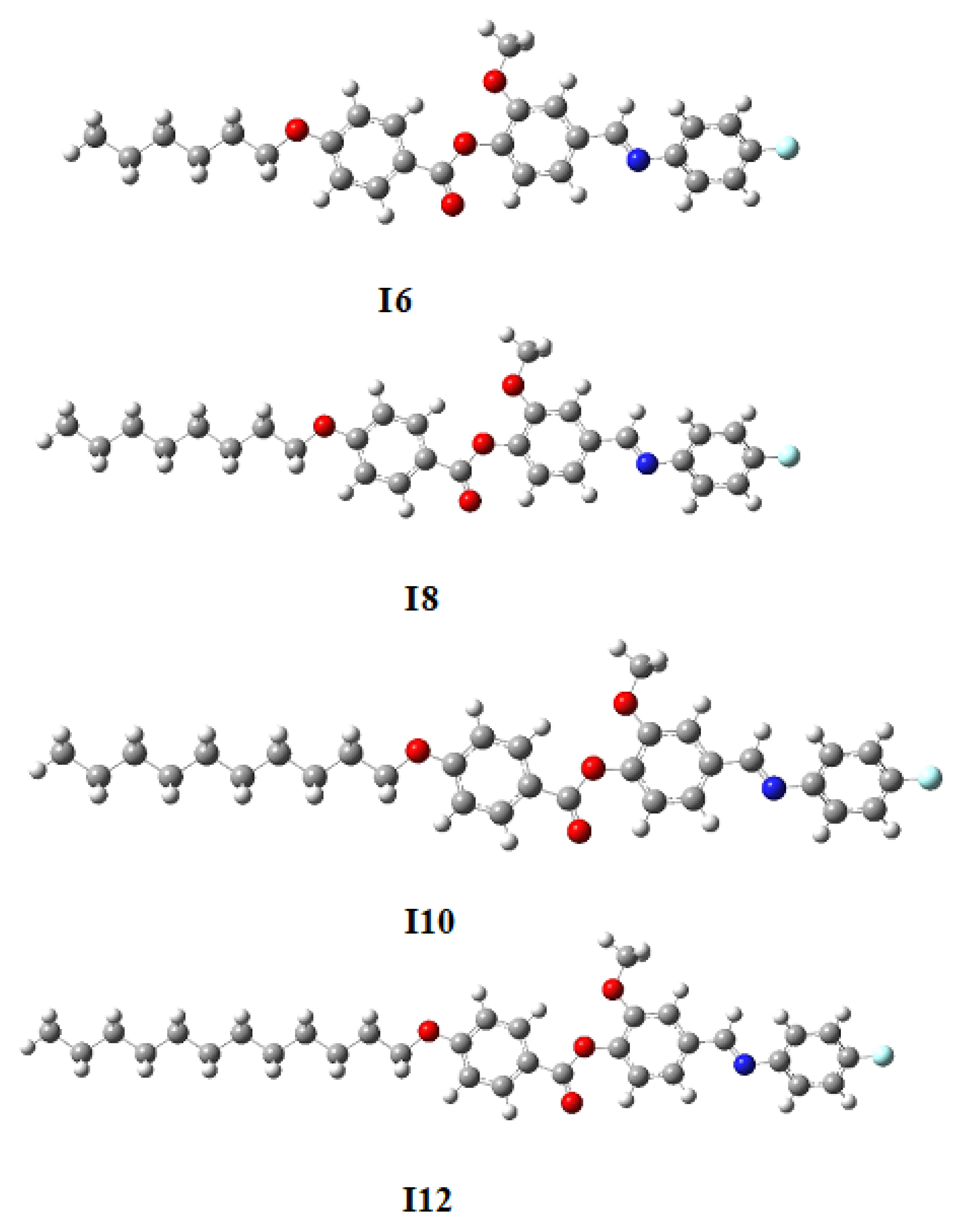
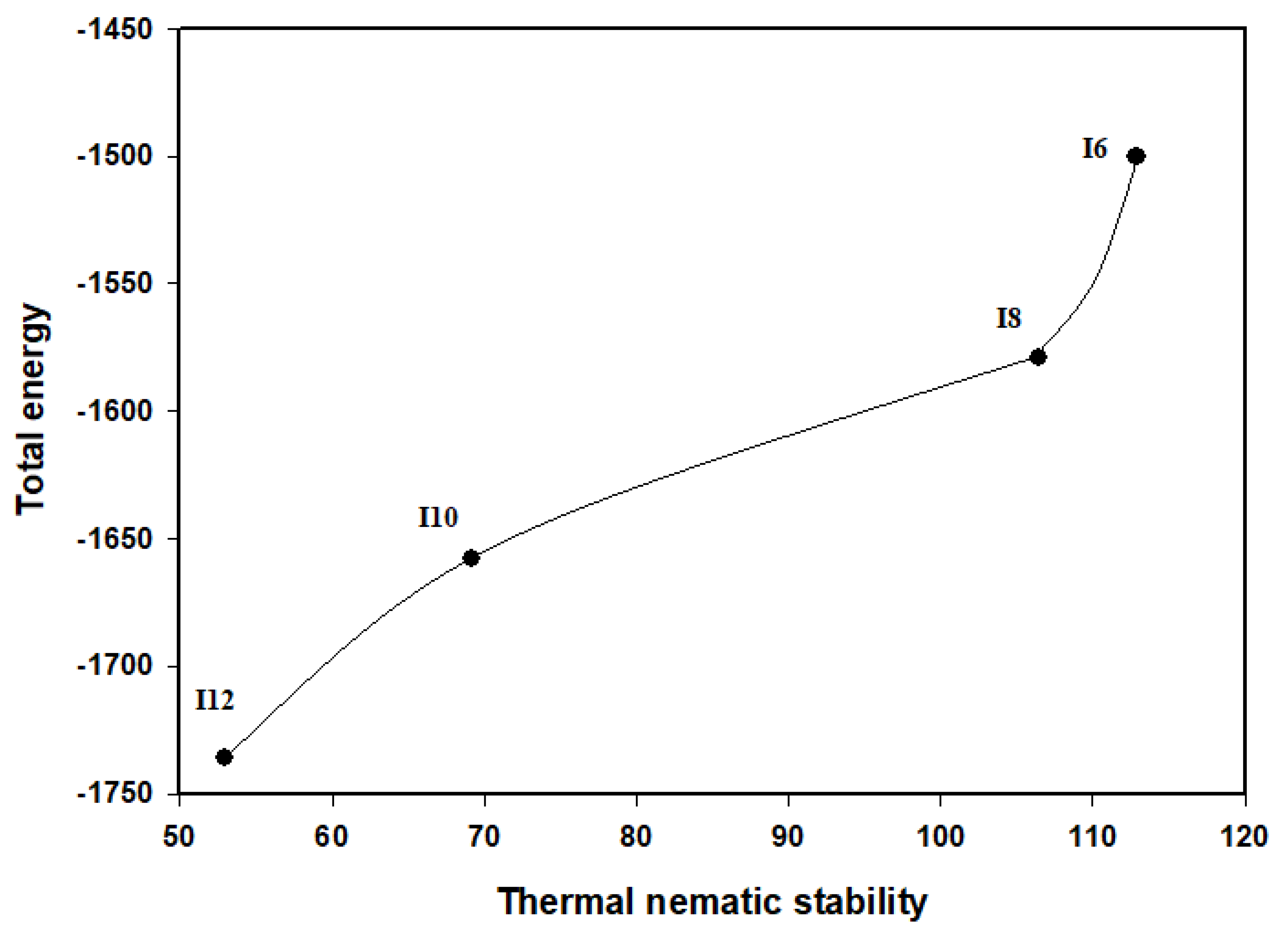
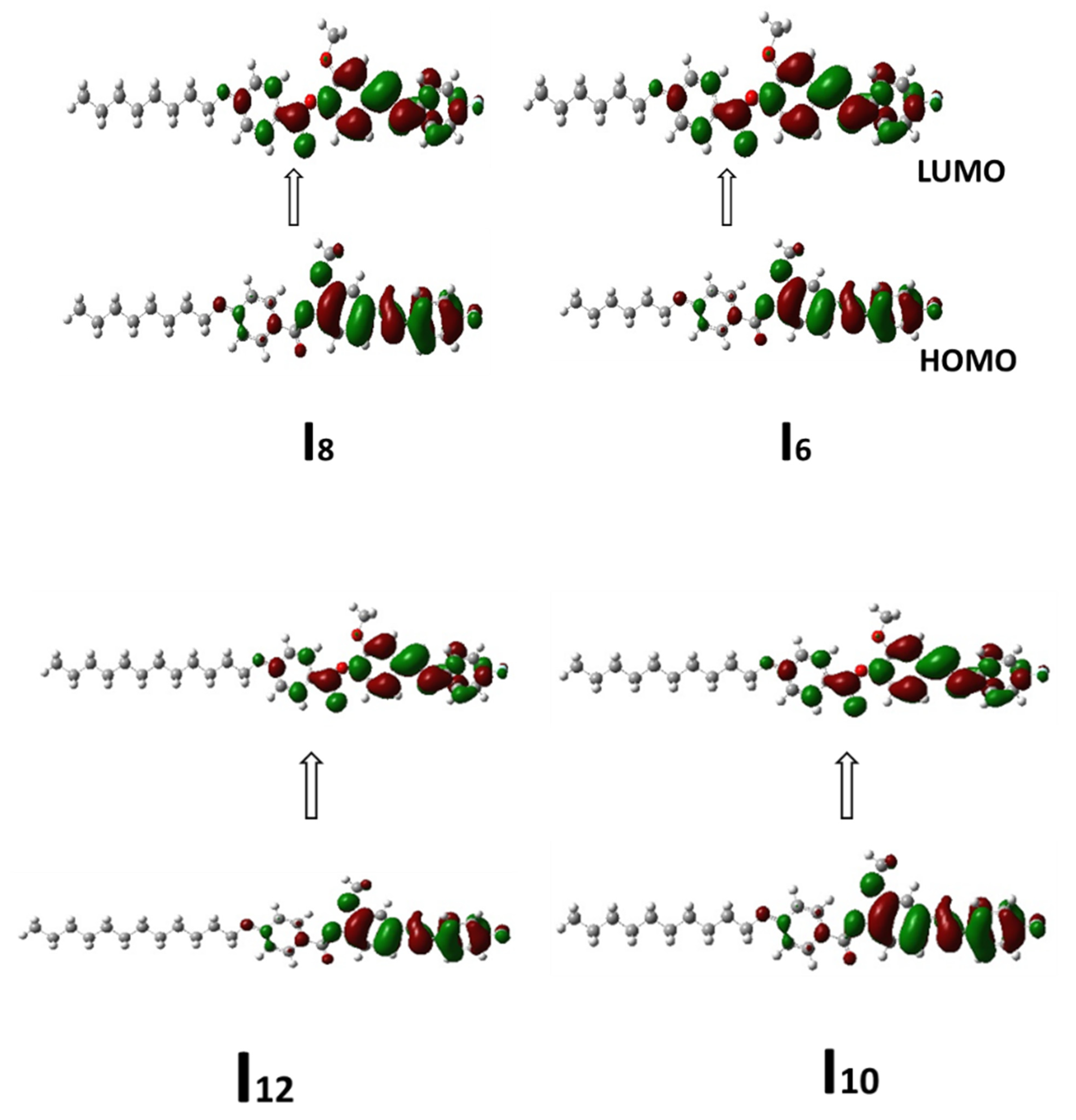
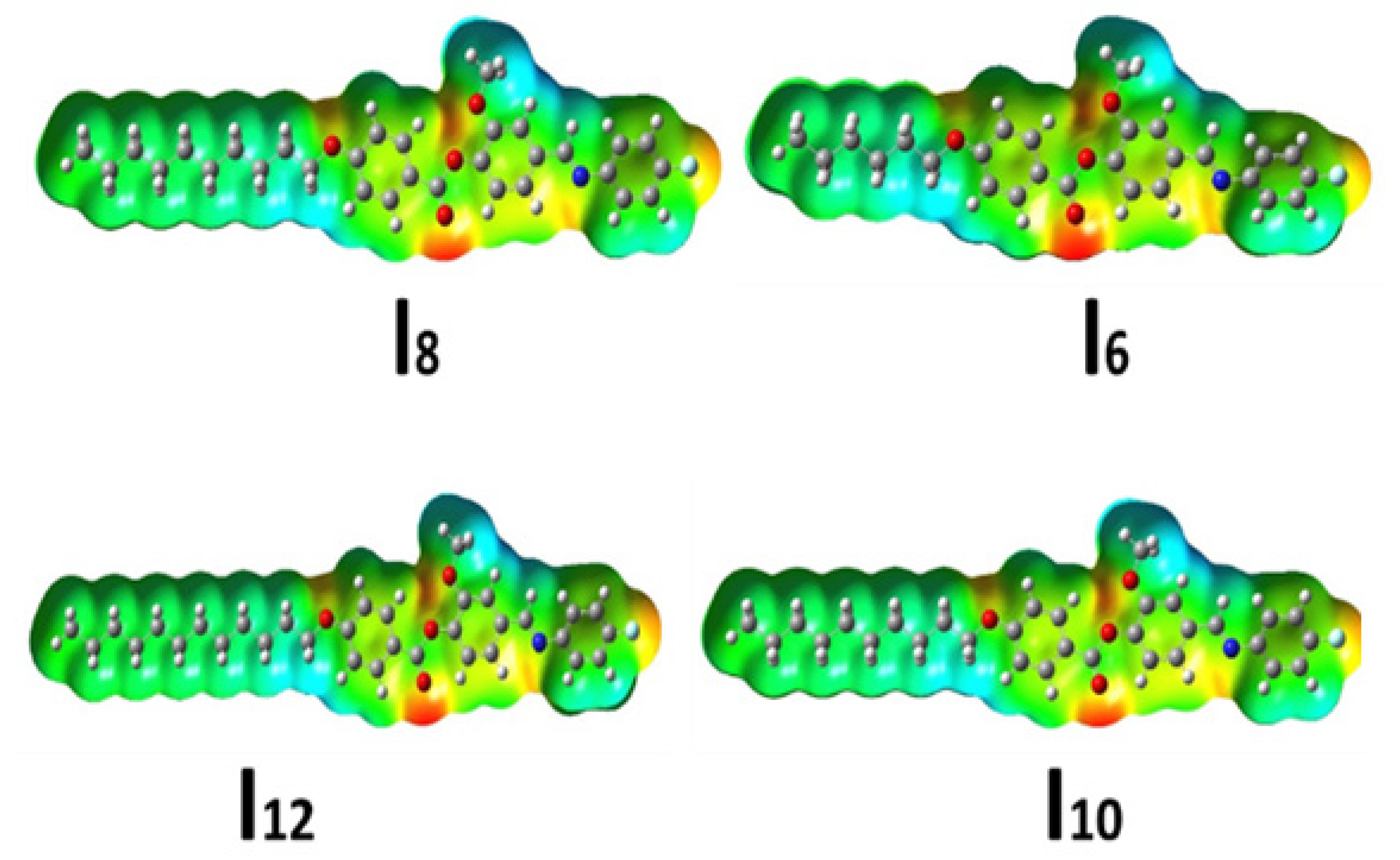
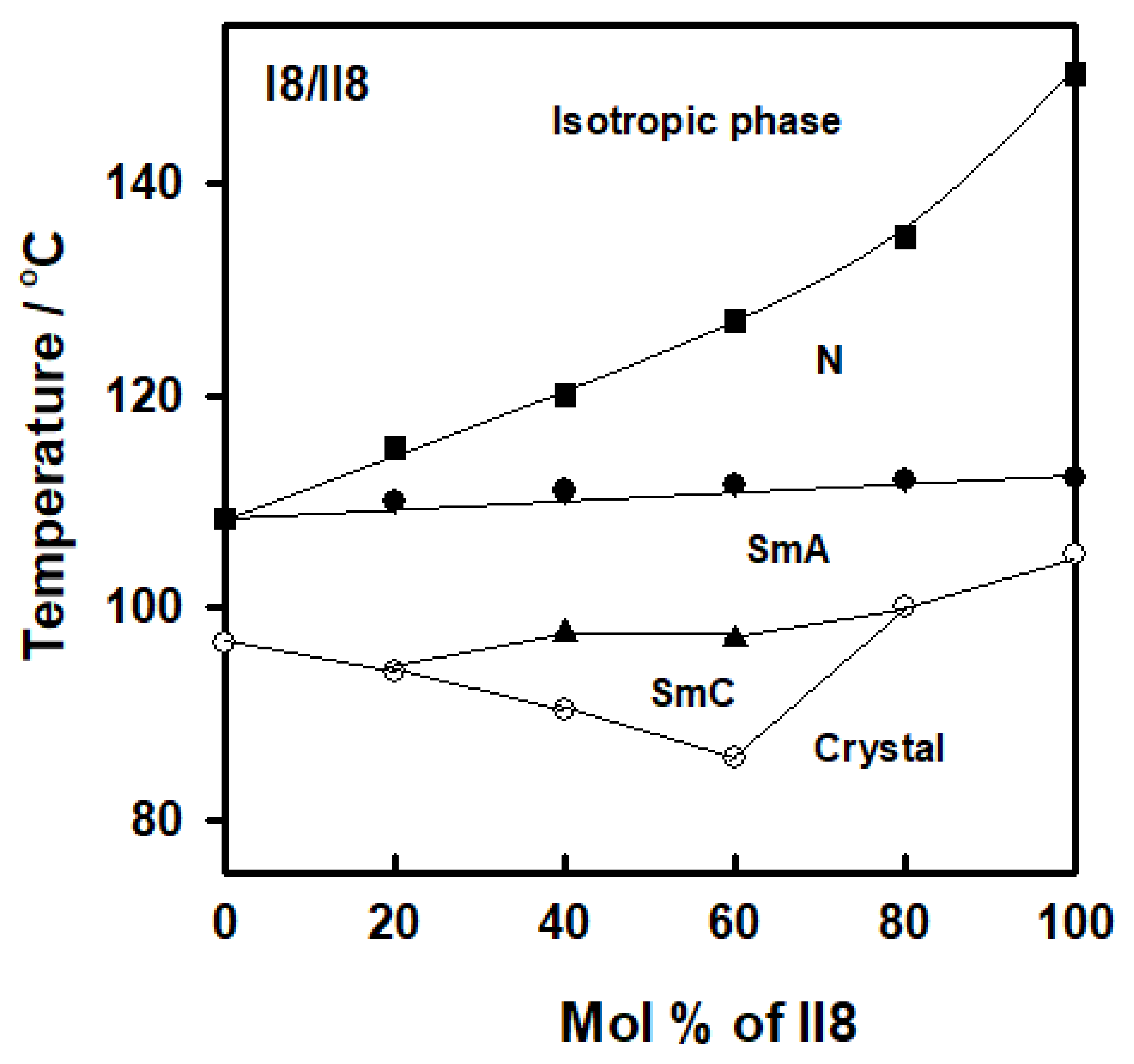

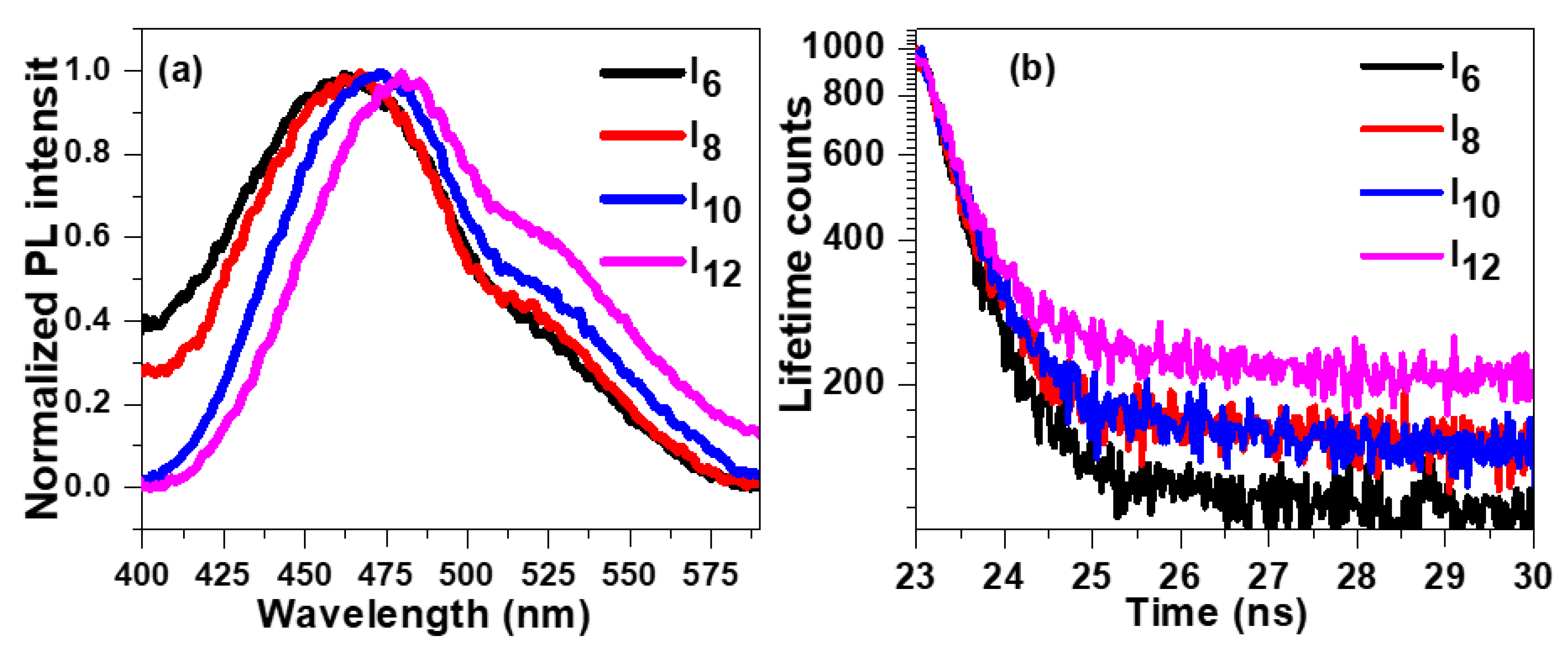
| Cycle | Upon Heating | Upon Cooling | ∆S/R | |||
|---|---|---|---|---|---|---|
| Comp. | TCr-I | TCr-N | TN-I | TI-N | TN-Cr | |
| I6 | 116.3 (42.22) | - | - | 112.9 (1.16) | - | 0.36 |
| I8 | 96.7 (45.64) | 108.4 (1.85) | 106.5 (1.13) | - | 0.36 | |
| I10 | 91.7 (36.14) | - | - | 69.2 (1.18) | 21.7 (19.35) | 0.41 |
| I12 | 78.1 (37.00) | - | - | 53.0 (1.13) | 32.33 (18.72) | 0.42 |
| Compound | ZPE (Kcal/Mol) | Thermal Energy (Kcal/Mol) | Enthalpy (Kcal/Mol) | Gibbs Free Energy (Kcal/Mol) | Entropy (Cal mol.k) |
|---|---|---|---|---|---|
| I6 | 311.781 | 331.655 | 332.247 | 268.439 | 214.013 |
| I8 | 347.608 | 369.186 | 369.779 | 301.645 | 228.522 |
| I10 | 383.435 | 406.717 | 407.310 | 334.847 | 243.042 |
| I12 | 419.262 | 444.249 | 444.842 | 368.056 | 257.542 |
| Comp. | Total Energy (Hartree) | EHOMO (ev) | EluMO (ev) | ∆E (ev) | Dipole Moment (Debye) | IE (ev) | EA (ev) | Polarizability Bohr3 |
|---|---|---|---|---|---|---|---|---|
| I6 | −1500.642 | −6.035 | −2.062 | 3.973 | 6.2270 | 6.035 | 2.062 | 374.73 |
| I8 | −1579.207 | −6.034 | −2.062 | 3.972 | 6.2646 | 6.034 | 2.062 | 398.87 |
| I10 | −1657.771 | −6.034 | −2.061 | 3.973 | 6.2850 | 6.034 | 2.061 | 422.75 |
| I12 | −1736.335 | −6.033 | −2.061 | 3.972 | 6.2981 | 6.033 | 2.061 | 446.49 |
| Sample | Absorption | λemission (nm) | Life Time τavg (ns) | ||
|---|---|---|---|---|---|
| λmax (nm) | λShoulder (nm) | Eg (eV) | |||
| I6 | 293 | 361 | 2.97 | 462 | 107 |
| I8 | 292 | 365 | 2.93 | 467 | 133 |
| I10 | 294 | 383 | 2.79 | 473 | 150 |
| I12 | 293 | 392 | 2.71 | 480 | 178 |
Publisher’s Note: MDPI stays neutral with regard to jurisdictional claims in published maps and institutional affiliations. |
© 2022 by the authors. Licensee MDPI, Basel, Switzerland. This article is an open access article distributed under the terms and conditions of the Creative Commons Attribution (CC BY) license (https://creativecommons.org/licenses/by/4.0/).
Share and Cite
Alrefaee, S.H.; Ahmed, H.A.; Khan, M.T.; Al-Ola, K.A.; AL-Refai, H.; El-Atawy, M.A. New Self-Organizing Optical Materials and Induced Polymorphic Phases of Their Mixtures Targeted for Energy Investigations. Polymers 2022, 14, 456. https://doi.org/10.3390/polym14030456
Alrefaee SH, Ahmed HA, Khan MT, Al-Ola KA, AL-Refai H, El-Atawy MA. New Self-Organizing Optical Materials and Induced Polymorphic Phases of Their Mixtures Targeted for Energy Investigations. Polymers. 2022; 14(3):456. https://doi.org/10.3390/polym14030456
Chicago/Turabian StyleAlrefaee, Salhah H., Hoda A. Ahmed, Mohd Taukeer Khan, Khulood A. Al-Ola, Hanaa AL-Refai, and Mohamed A. El-Atawy. 2022. "New Self-Organizing Optical Materials and Induced Polymorphic Phases of Their Mixtures Targeted for Energy Investigations" Polymers 14, no. 3: 456. https://doi.org/10.3390/polym14030456
APA StyleAlrefaee, S. H., Ahmed, H. A., Khan, M. T., Al-Ola, K. A., AL-Refai, H., & El-Atawy, M. A. (2022). New Self-Organizing Optical Materials and Induced Polymorphic Phases of Their Mixtures Targeted for Energy Investigations. Polymers, 14(3), 456. https://doi.org/10.3390/polym14030456







